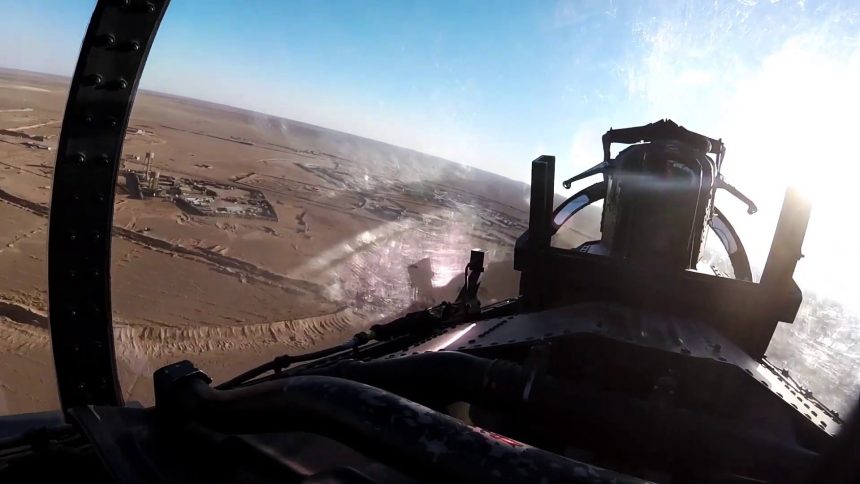The 492nd FS OIR (Operation Inherent Resolve) 2020 video includes an interesting low pass over al-Tanf garrison in Syria.
In October 2020, the 492nd Fighter Squadron “Bolars”, belonging to the 48th FW based at RAF Lakenheath, returned to the UK after a six-month rotation in support of Operation Inherent Resolve (OIR) at Muwaffaq Salti Air Base, in Jordan. Over the course of six months, the Squadron flew over 8,500 hours and dropped approximately 350 precision-guided munitions during CAS (Close Air Support) and Air Interdiction missions in support of OIR.
The “Bolars”, that returned to RAF Lakenheath with their 14 Strike Eagles decorated with bomb markings and nose art featuring comic book characters, movie and television show villains, and more, have recently released their deployment video that includes footage of the F-15E at work in the Middle East.
There are a lot of noteworthy details: you get an overview of the weapons (GBU-38s, GBU-54s and the GBU-31s), you can see the Strike Eagle being refueled, releasing flares at sunset and using the 20 mm M61A1 Vulcan gun at night.
Something interesting can be seen at the 01:56 mark of the clip as one F-15E can be seen performing a low pass over a military base in Syria, identified as being al-Tanf garrison, located in a remote desert outpost in southern Syria near the Jordanian border.
USAF F-15E low level at Tanf garrison https://t.co/EL3g6TEieg https://t.co/O22UDmCoIq pic.twitter.com/SFZtit2g6x
— Samir (@obretix) March 9, 2021
Al-Tanf is a small, strategic garrison housing American commandos. The base is surrounded by a 55 km deconfliction zone and has housed, depending on the period, some hundred coalition and partner forces acting as an anti-ISIS force in the war against Daesh.
Force protection against threats at the remote base has always been a primary concern for the U.S. Central Command. For this reason, armed aircraft constantly patrol the airspace around the U.S. outpost. You may remember what happened in July last year, when a U.S. Air Force F-15C Eagle performed a visual daytime intercept and inspection of an Iranian Mahan Air A310 passenger airliner flying as IRM1152 from Tehran, Iran, to Beirut, Lebanon, that flew in the vicinity of the U.S. base. As we reported back then, U.S. Central Command spokesman Capt. Bill Urban said that the U.S. F-15 was on a “routine air mission” and flew “Standard visual inspection of a Mahan Air passenger airliner to ensure the safety of coalition personnel at al-Tanf garrison”.
The low pass over the garrison was probably carried out for deterrence purposes . A “show of presence” or SOP, to intimidate hostile actors in the vicinity of the base while boosting the morale of the local allied forces.
Here’s how we described the differences between a “show of force” and a “show of presence” in an article published last year about the low and fast pass by an F-16 over the northeastern Syrian city of Hasakah, where several Islamic State militants had tried to escape from a Syrian prison:
Although many consider the low and fast flyby a “show of force” (SOF) is worth remembering that this should be considered a “show of presence” (SOP): the first usually implies the use of weapons or warning gun shots (not directly on the target but in its vicinity), the second is normally carried out to scare someone off with noise. But it’s not a rule:
“For sure, what we can say is that a SOF is called when there is the need for borderline “kinematic” missions that may include release of flares or even warning shots,” says our contributor and combat pilot Alex “Gonzo” Olivares, who’s flown the Tornado in combat. “During a reconnaissance mission over Afghanistan, I was called to carry out an immediate SOP / SOF in favor of some ground troops that were under attack. On that occasion the purpose was to show the insurgents that the troops could have had the support of the air component so we released flares and also used the afterburner.”
“Dealing with SOF/SOP what I can say is that the doctrine is very broad and the way these are performed depend very heavily on the rules of engagement (ROE) of the coalition but also and above all on the scenario: for example the tactics may change if the flyby has to take place as part of a crisis scenario or during peacetime ops. In addition, a Show Of Force is usually ordered to bolster and reassure friendly forces. Moreover these flybys are military in nature but often serve both diplomatic and military purposes: they may even influence other governments or political-military organizations to refrain from belligerent acts.”
Whatever, the purpose is to disperse or intimidate the enemy. These shows are usually carried out by one aircraft, with the other one providing air cover and armed overwatch. The presence of a wingman is important as his/her role is to spot potential threats (for instance the plume of a SAM – Surface to Air Missile) and radio instructions so that the other aircraft, flying low, within the envelope of SAMs, MANPADS and small arms, can visually detect them, release flares and avoid the incoming missile or flak (anti-aircraft fire).









